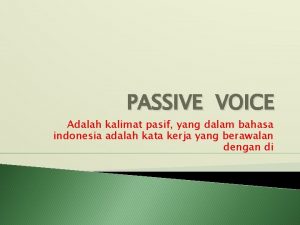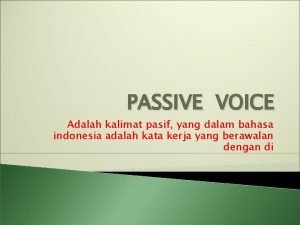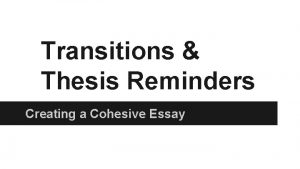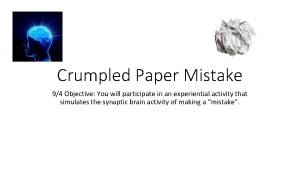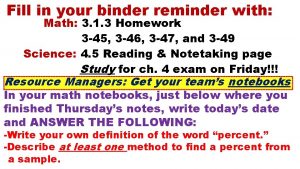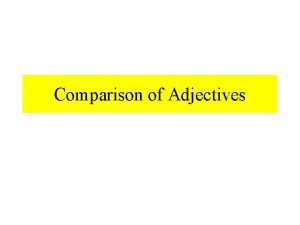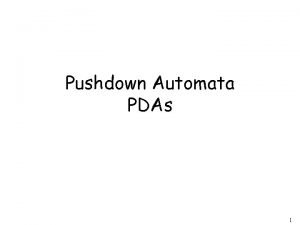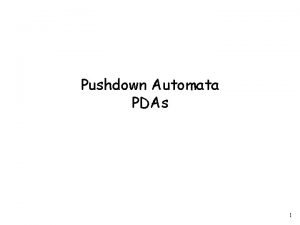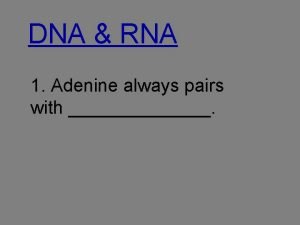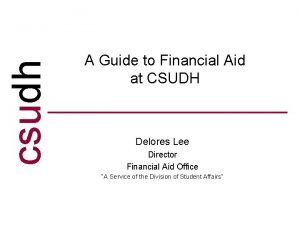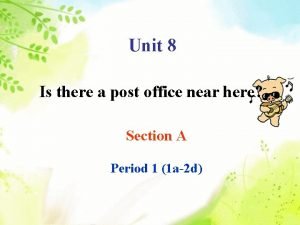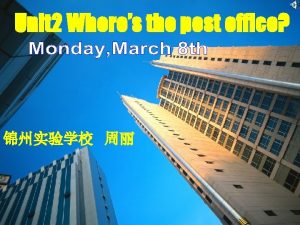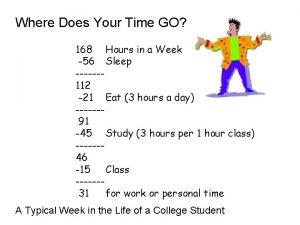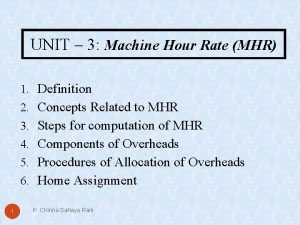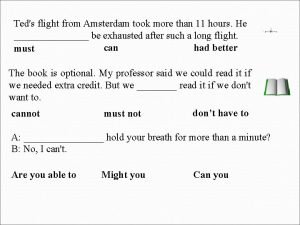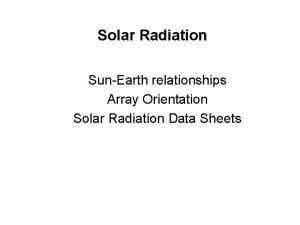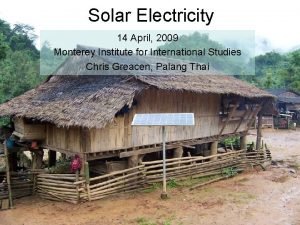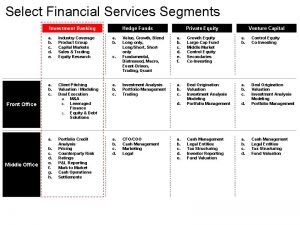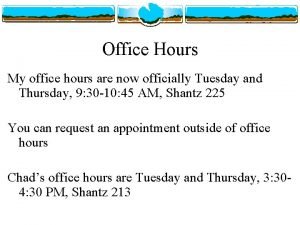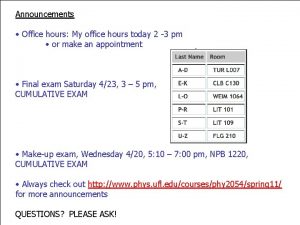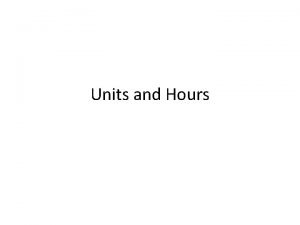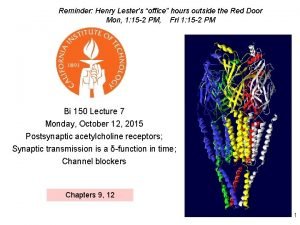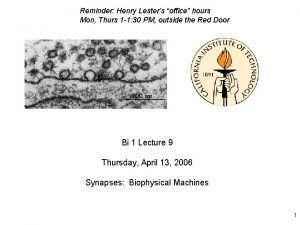Quiz 5 Reminder Emilys Office Hours next week















































- Slides: 47

Quiz 5 Reminder: Emily’s Office Hours next week are different: Wednesday 11/12 from 1 -2 pm in TB 114 Monday 11/10 OH are cancelled 1

Physics 7 C Fall 2008 Lecture 6: Field model Dipole field Electric Force & Electric Field, Magnetic Force & Field If time permits, begin Electric Potential Energy & Electric Potential

Tesla Coil l Powered by electricity Observe the top--what do you see? Observe as a fluorescent lamp is brought near--what do you see? Takeaway message: the device is generating something electrical throughout space in the vicinity of the coil. 3 Image: http: //tommcmahon. typepad. com/photos/uncategorized/2007/08/16/teslacoil 2. jpg

Field Model: What is a field? l …some physical quantity that has a value “everywhere, ” that can either change from location to location or stay the same. -Physics 7 C Course Notes l In physics, a “field” refers to a quantity that has a value for every point in space. ” -homework from DLM 10 Is temperature a field? 4

Temperature Field l What do places with the same color have in common? 5

True or False l Gravity is more on Earth than the moon. 6

True or False l Gravity is more for a feather on Earth than for an elephant on the moon. 7

Field Model: Gravitation l A source mass m 1 creates a gravitational field in a direction toward the source mass with a value g=Gm 1/r 2 l l The net Gravitational Field is the sum of all the source fields. A test mass m 2, placed in a gravitational field, experiences a gravitational force l l Magnitude given by F=m 2 g Direction of force: Attractive 8

Electric Phenomenon l l Like gravitational force, the electrical interaction between objects at a distance. Electrical interaction depends on charges 9

New Models: l Electric Field and Forces Field, Forces, Potential Energy, and Potential l Magnetic Field and Forces l 10

Applying Field Model to Electrical Phenomena l l A charge Q generates an Electric Field EQ Charge q, placed in an electric field EQ, experiences a force Felec Q on q=q. EQ. How might we draw the electric field? 11

Applying Field to Electrical Phenomena l l A charge Q generates an Electric Field EQ Charge q, placed in an electric field EQ, experiences a force Felec Q on q=q. EQ. l l For + test charge, force points in the same direction as field. For - test charge, force points in opposite direction of field 12

Phenomenon: Van de Graaff Generator l Observe what happens as the generator builds charge. l What happens when a neutral conductor is brought near the generator? a) No affect b) Pulled toward c) Pulled away 13

Phenomenon: Van de Graaff Generator l Next: Touch the conducting sphere to the generator…what will happen now? a) No affect b) Pulled toward c) Pulled away 14

Understanding Fields & Forces l True or False: l The generator creates an electric field whether or not another object is placed near it. 15

Understanding Fields & Forces l True or False: l The generator creates an electric force whether or not another object is placed near it. 16

Applying Field to Electrical Phenomena l l A charge Q generates an Electric Field EQ Charge q, placed in an electric field EQ, experiences a force Felec Q on q=q. EQ. l l For + test charge, force points in the same direction as field. For - test charge, force points in opposite direction of field 17

Superposition of Fields l l The electric field is a vector field To find the field from multiple sources, add the vectors! Which way is the electric field at the marked spot? - 18

Superposition of Fields l l The electric field is a vector field To find the field from multiple sources, add the vectors! 1) Which vector might be the electric field from the top charge? a d - b c 19

Superposition of Fields l l The electric field is a vector field To find the field from multiple sources, add the vectors! a 2) Which vector might be the electric field from the bottom charge? d - b c 20

Superposition of Fields l Which direction does the net Electric Field point? c Etot = 0 d Neither a nor b (but not 0) a E- - E+ b 21

Checking Understanding: l If I put a charge at the marked location, which way will the force be? a e Insufficient Information b - d c 22

Field vs. Force l How many objects are required to create a electrical field? At least… a) b) c) d) 0 1 2 3 23

Field vs. Force l How many objects are required to create a electrical force? At least… a) b) c) d) 0 1 2 3 24

Models of Electric Phenomena: l Electric Field and Forces l Each source charge Q generates an Electric Field EQ l l l The net Electric Field is the sum of all the source fields Charge q, placed in an electric field Etot, experiences a force Felec on q=q. EQ. l l l Direction convention shown at right For + test charge, force points in the same direction as field. For - test charge, force points in opposite direction of field Field, Forces, Potential Energy, and Potential l PE & Forces--started in 7 A Potential--started in 7 B We’ll develop more in DLM 13 & 14 25

Field Model: l A source (A) field in a direction l l The net (B) source fields. creates a. l _ _ _ field is the sum of all the A test (A) , placed in a field, experiences a (B) l (B) _ (B) force _ Magnitude given by _____ Direction of force: _____ 26

Field Model: Magnetism l A source ______ creates a magnetic field in a direction given by _______. l l The net magnetic field is the sum of all the source fields. ______, placed in a magnetic field, experiences a magnetic force l l Magnitude given by _____ Direction of force given by _____ 27

A little background l Compasses or bar magnets, if allowed, will always orient north-south Why? 28

A little background l Compasses orient in the same direction as the magnetic field. 29

A little background l Iron fillings also orient in the same direction as the magnetic field. 30

Magnetic Field from a wire l If we allow iron fillings freedom to rotate, and put them near a current -carrying wire, this is how they align: 31

Magnetic Field from a wire l If we place compasses around a long currentcarrying wire, this is how they align (view is looking down wire) 32

Field Model: Magnetism l A source moving charge creates a magnetic field in a direction given by _______. l l The net magnetic field is the sum of all the source fields. A test moving charge, placed in a magnetic field, experiences a magnetic force l l Magnitude given by _____ Direction of force given by _____ 33

Phenomenon: Magnet near an electron beam l l The beam is composed of electrons--moving charges Observe the effects of a large magnet on the beam… 34

Phenomenon: jumping wires l Two wires l l Initially no current (observe wires) Connect both wires to a generator, making current flow. Observe: l l What happens to the wires? What happens if I reverse the direction of the current in one wire (compared to first time)? What happens if I reverse the direction of the current in both wires (compared to the first time)? What would happen if I could put current in only one wire? 35

Reviewing what you’ve previously studied… l Gravitational Potential Energy 3 2 1 36

Relationship between Potential Energy and Force 0 r Potential Energy - 37

Relationship between Potential Energy and Force 0 Potential Energy - r 1 2 3 Negative means decrease of PE with decreasing r 38

Relationship between Potential Energy and Force 0 Potential Energy - r 1 F = - DPE/Dr, the - slope 2 3 Force increases with greater slope More slope closer to earth means F is greater there 39

Reviewing what you’ve previously studied… l Relationship between Potential Energy and Force. • Magnitude of Force = slope of PE vs. r graph. 1 4 3 • 2 40

Defining a new quantity l Gravitational Potential: How much Potential Energy would a mass m have if placed (x, y)? y 3 2 1 x 41

Electric Field and Potential: Constant Electric Field l Slope of the potential l constant as a function of distance. negative Electric field is l l constant as a function of distance positive 42

Electric Potential of a point charge: Positive and Negative Charge. l Not all potentials are straight lines! 43

Equipotential Surfaces: Lines where V is the same. l Equipotential surfaces for a point charge. l l Circles are 0. 5 V apart. Distance between circles is NOT uniform! l Circles get closer and closer toward center l Potential grows like 1/r 44

Putting it all together… l Which quantities depend only on source charge(s)? a) b) c) d) Electric Field (E) Electric Force (F) Electric Potential Energy (PE) Electric Potential (V) 45

Putting it all together… l Which are vector quantities? a) b) c) d) Electric Field (E) Electric Force (F) Electric Potential Energy (PE) Electric Potential (V) 46

Putting it all together… l Which quantities are related by slopes (that is, if you take the slope of one, you get the other) a) b) c) d) Electric Field & Electric Force Electric Potential Energy & Electric Potential Electric Force & Potential Energy Electric Field & Electric Potential 47
 X.next = x.next.next
X.next = x.next.next Week by week plans for documenting children's development
Week by week plans for documenting children's development His landlord asked him to move
His landlord asked him to move Let's plan for next week
Let's plan for next week The court will try the case next week passive voice
The court will try the case next week passive voice Next week we are going to
Next week we are going to Cohesive essay
Cohesive essay Stir you up by way of reminder
Stir you up by way of reminder Proactive patient outreach
Proactive patient outreach Advertising mean
Advertising mean I693 reminder letter
I693 reminder letter How to uncrumple paper
How to uncrumple paper Binder reminder
Binder reminder Critical reminder
Critical reminder Adjectives for reminder
Adjectives for reminder Computation symbols
Computation symbols Pda
Pda Pda
Pda Pda reminder 1
Pda reminder 1 In rna adenine always pairs with
In rna adenine always pairs with Thanks for the reminder.
Thanks for the reminder. Sql reminder
Sql reminder Plot for flowers for algernon
Plot for flowers for algernon Twu financial aid office
Twu financial aid office Kent state financial aid office hours
Kent state financial aid office hours Cal state dominguez hills financial aid
Cal state dominguez hills financial aid Instructor office hours
Instructor office hours Nr 601 test bank
Nr 601 test bank The bank is between the post office and the restaurant.
The bank is between the post office and the restaurant. The bank is between the post office and the restaurant.
The bank is between the post office and the restaurant. Who is he
Who is he Office and factory
Office and factory Deductive reasoning example
Deductive reasoning example Every quiz has been easy therefore the quiz will be easy
Every quiz has been easy therefore the quiz will be easy 3 hours to go images
3 hours to go images Have you finished your homework yet?
Have you finished your homework yet? Puget sound health care
Puget sound health care Florida intrastate hours of service rules
Florida intrastate hours of service rules Ewu library hours
Ewu library hours Utsa fiscal services number
Utsa fiscal services number Mhr definition
Mhr definition 24 hour time format
24 hour time format 11:00 in 24 hour clock
11:00 in 24 hour clock Jenny's engagement ring is enormous it must be a fortune
Jenny's engagement ring is enormous it must be a fortune Mcps virtual ssl hours
Mcps virtual ssl hours Hours of sunlight map
Hours of sunlight map Peak sun hours
Peak sun hours Select financial services
Select financial services


